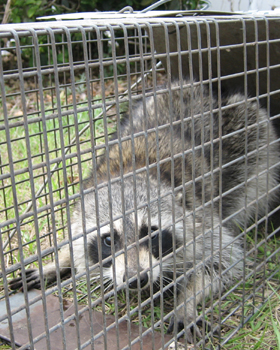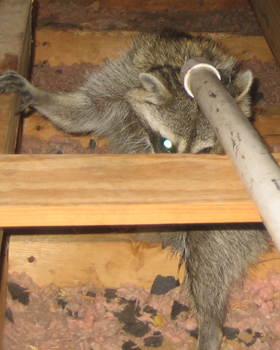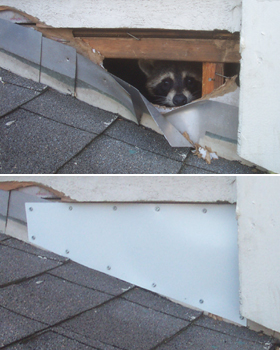FREE - Again, we must reiterate that in many cases, you can solve the raccoon problem in an easy and humane manner with simple, free techniques. Read our
how to get rid of raccoons yourself guide for more info.
AVERAGE PRICES - Unfortunately, there is no average standard price in professional nuisance wildlife control. In some ways, it's like asking for the average
price of car repair. There's no good answer, because every job is very different. In addition, different companies simply charge different rates, with no good rhyme or
reason, other than the business motivations of the company. Higher cost does not always correlate with better service. All that said, we will analyze some of the types of
raccoon jobs below.
CAGE TRAPPING AND REMOVAL - We at Humane Wildlife Removal Org. discourage the use of cage trapping, for several reasons. In most states, the animals must
be euthanized, and even if they are relocated, they often will not survive. In addition, cage trapping is only a temporary fix to a raccoon conflict, and after trapping, many
people soon find themselves in the same situation again, with a new raccoon. However, many companies engage in cage trapping. It's sort of the quintessential job - for a
wildlife guy to catch the animal in a cage and triumphantly cart it away. Most companies will charge a service fee or trap setup fee to come to the house and set traps. Then
they will often charge a fee per animal, or per return trip. These costs can vary to as little as $150 total, to much higher in some cases over $1000, depending on the company
and the number of service trips and number of animals caught.
RACCOONS IN THE ATTIC - This is a situation that can often be solved easily for free or for very little money (read our raccoon in the attic
guide). But in other cases, it is a legitimately challenging situation that requires professional work. In the event that a pro has to manually remove the baby raccoons and the
mother. Or remove the young and trap the mother and bring them all away together, the minimum is usually over $300, usually higher than that. Much of the expense comes from
repairs and cleanup.
DAMAGE REPAIRS - If a raccoon is in a house or attic, they have surely damaged part of the home to get inside, or gone through a glaringly open house problem. This
will require repair to fix, and the repairs must be very strong to keep future raccoons out. If you are handy, you can perform these repairs yourself. See our raccoon
damage page. In addition, the raccoon may have damaged large parts of the inside of the attic, including tearing all the duct work, the insulation off of piping, or removing or
trampling insulation. This could require a professional HVAC company, or plumber, or insulator. The cost of repairs can be little, or very high.
EXCLUSION BARRIERS - If a raccoon lives under an elevated house, shed, porch, deck, or other ground structure, after removal, a homeowner might consider an exclusion barrier
to keep future raccoons (and stray cats, skunks, etc.) from living under there. This is a steel mesh barrier, bolted to the structure, and burrowing into the ground. Costs for this
can cost $10-$20 per linear foot, or more.
ATTIC CLEANUP - This is an area to potentially beware of. It's true that raccoons in an attic will defecate quite a bit. It's also true that their droppings can contain
raccoon roundworm (Baylisascaris procyonis), the eggs of which can survive a long time, become airborne, breathed in, and can infect humans. It's very rare, but it's possible. Raccoons
can also bring parasites into the attic, although they won't last long. It's possible that the waste and urine will attract cockroaches, or new wildlife, etc. So many people do consider
it a good idea to clean the attic. That said, there is a whole industry surrounding the cleaning of attics inhabited by raccoons, under the special loophole that cleanup is often covered
by homeowner's insurance. Insurance bars against covering rodent damage, but raccoons are not rodents. Thus some companies exploit this,
aggressively seek to clean attics, and bill the
insurance, usually over $10,000. This cost is not to you, but be aware that some companies work
solely to perform these cleanups, and will work to get them, regardless of necessity. Other
companies will do more modest cleanup, including removal of all feces, contaminated insulation, and proper antimicrobial fogging, for as little as $500.
Really, the best way to find out the cost is to call a local raccoon professional, and get an estimate! Some will give ballpark estimates on the phone, some will give free on-site inspections,
but not all. For effective ways to solve a raccoon problem yourself, or to find local help and prices, click the below buttons:



